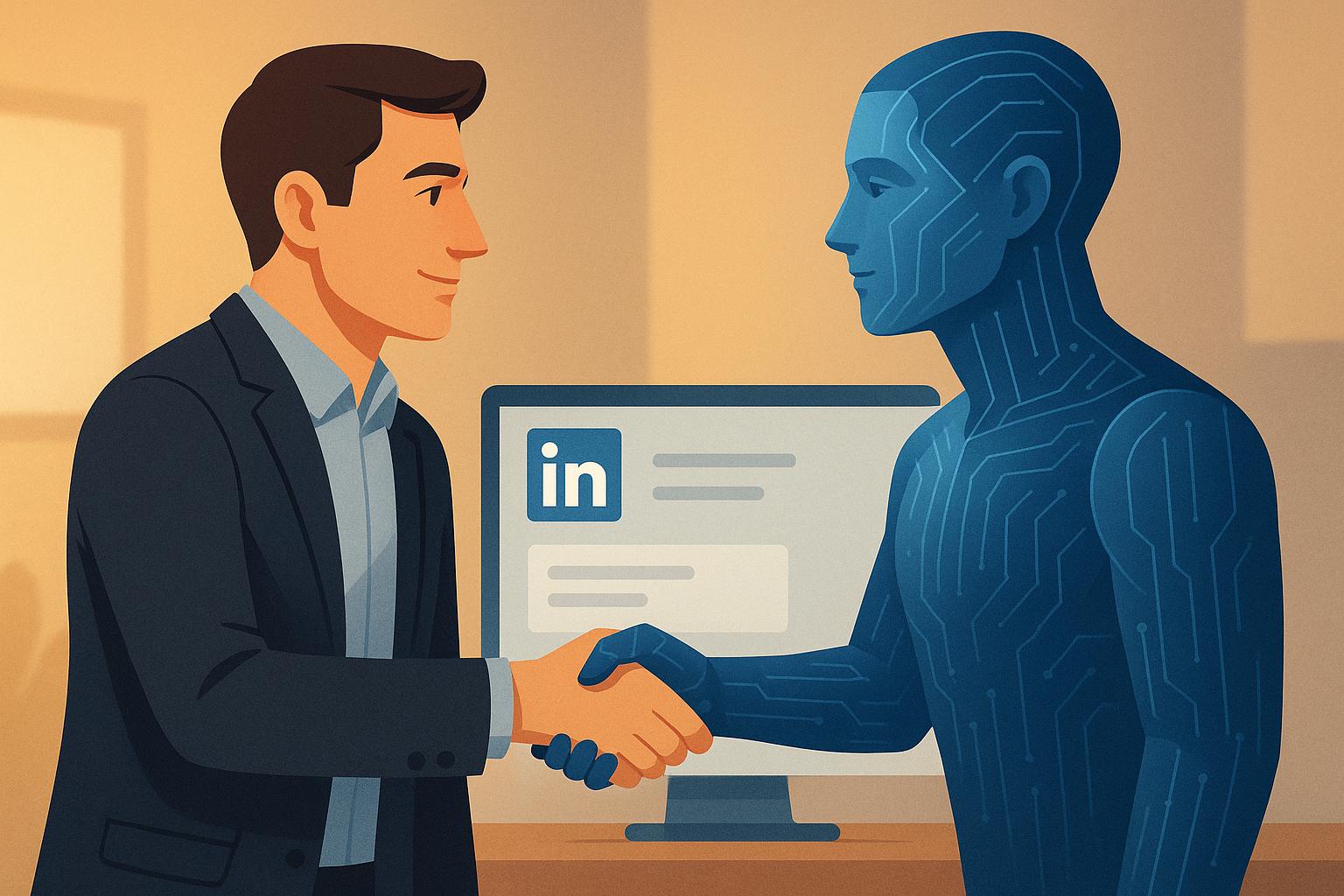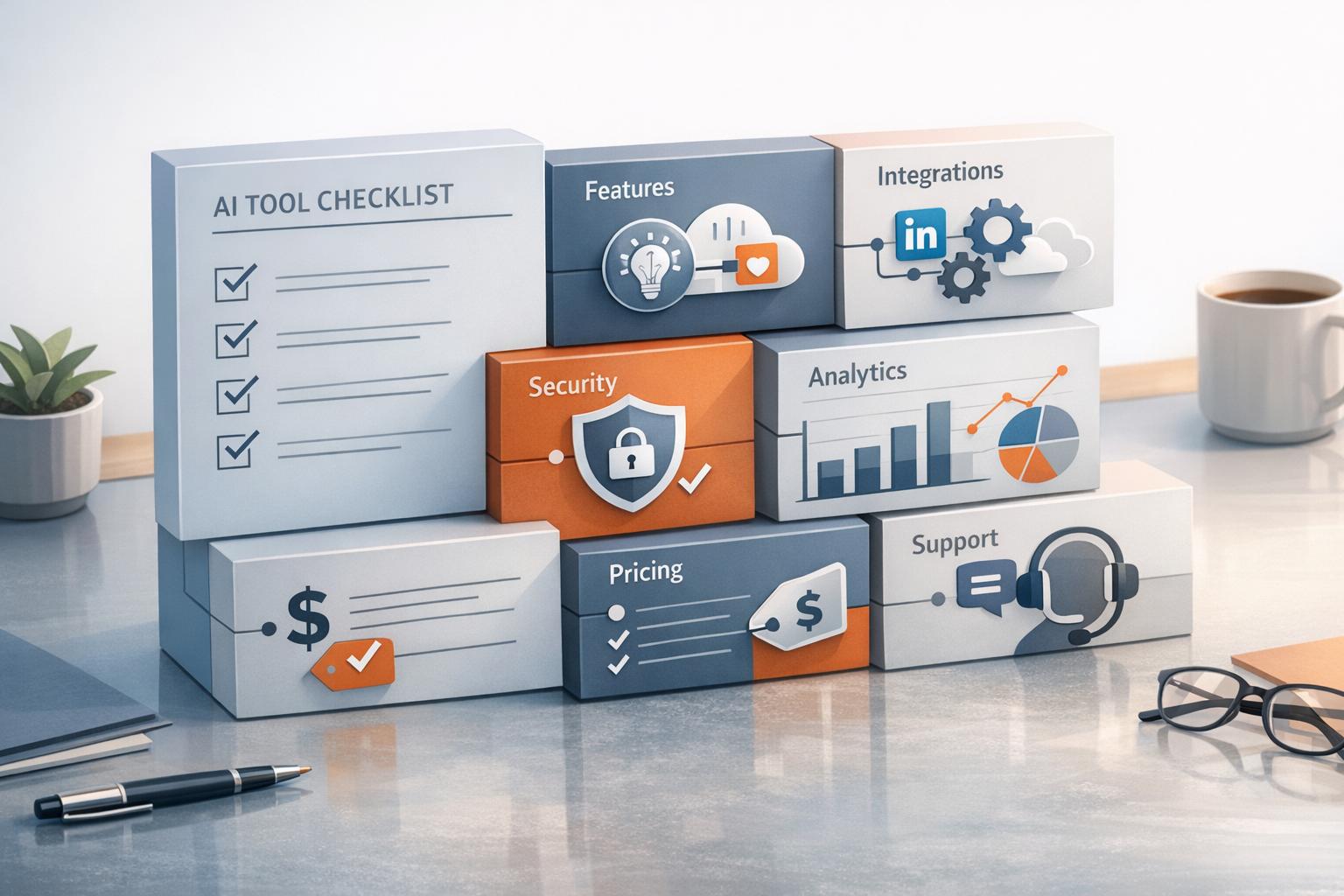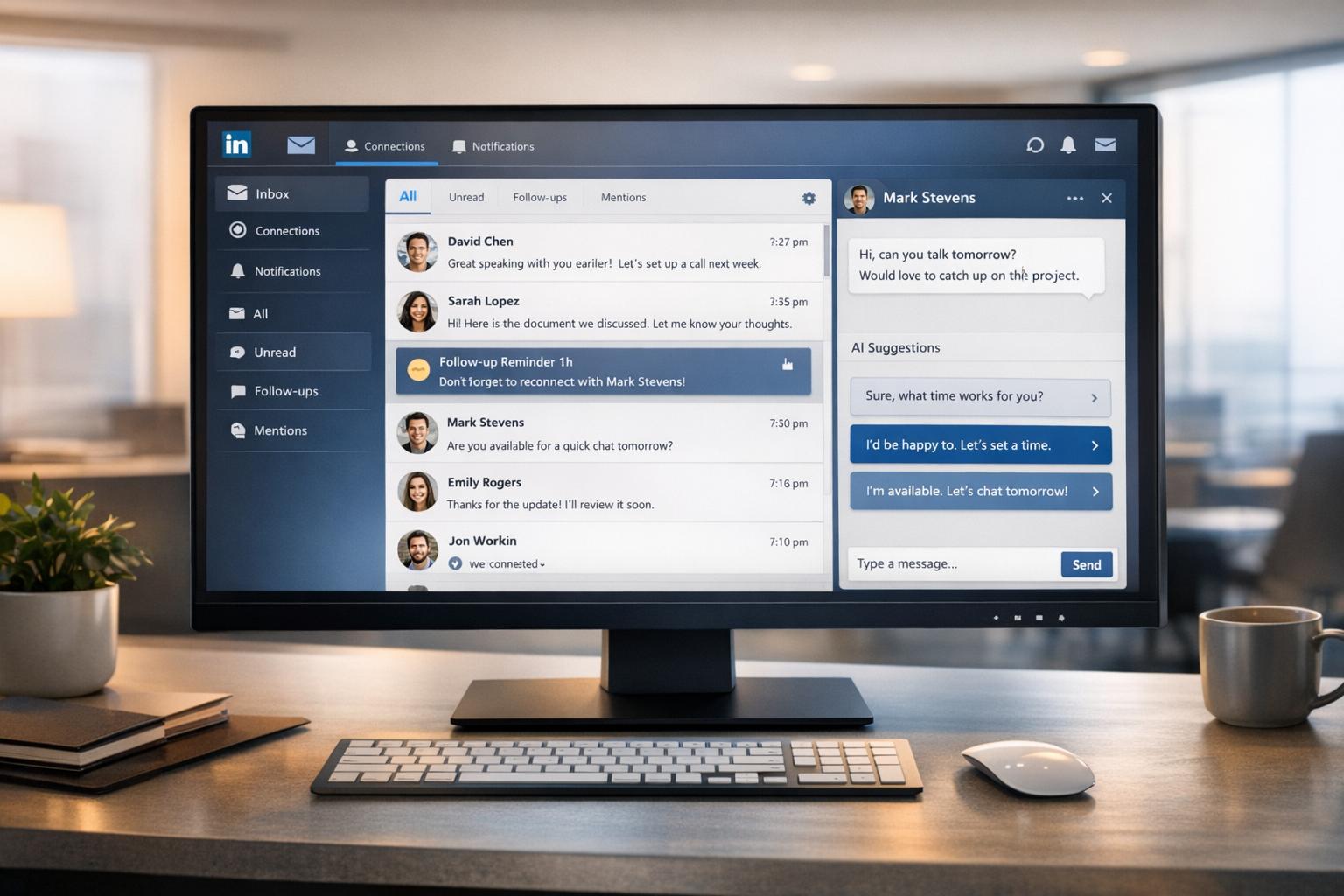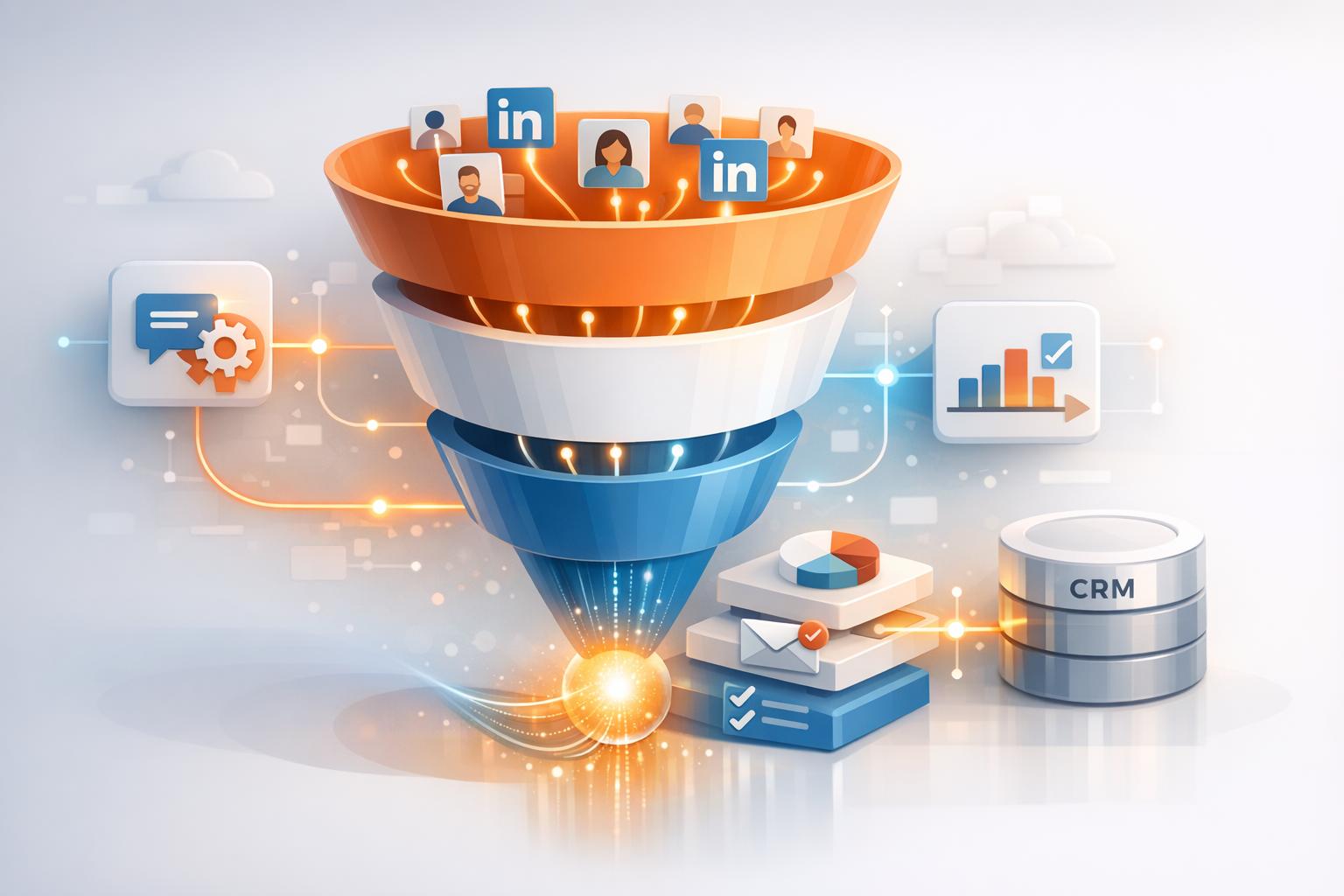
LinkedIn outreach can be time-consuming, but AI tools are changing the game. By automating follow-ups and personalizing messages, professionals are seeing response rates increase by up to 25% and conversions improve by 50%. Here's what you need to know:
- Personalization matters: AI analyzes profiles, recent activity, and company updates to craft tailored messages, boosting connection acceptance rates to 55% and reply rates to 19%.
- Timing is key: Quick responses within an hour can improve conversions by up to 7x. Consistent follow-up sequences (4–7 messages) yield the best results.
- Unified inboxes streamline communication: Centralizing LinkedIn activity and automating follow-ups saves time and ensures no lead is missed.
- Behavioral triggers improve engagement: AI reacts to actions like profile views or content interactions, enabling timely, relevant follow-ups.
AI tools like SalesMind AI simplify LinkedIn outreach by combining automation with human-like messaging. Users report saving 30 minutes daily, closing deals a week faster, and generating an average pipeline value of $100,000 per month.
Want better results? Focus on timing, personalization, and adding value in every message while staying compliant with LinkedIn's rules.
This AI LinkedIn Agent do Follow Ups till you Get a Reply
Best Practices for AI-Driven LinkedIn Follow-Up Scheduling
To get the most out of AI-powered LinkedIn follow-ups, focus on timing, personalization, and delivering value. These strategies help turn your outreach into meaningful interactions rather than intrusive messages. Let’s dive into how smart scheduling, customized messaging, and valuable content can enhance your LinkedIn approach.
Timing and Frequency of Follow-Ups
Timing is everything when it comes to follow-ups. Studies suggest that reaching out within 24–48 hours after the initial contact significantly boosts engagement [3]. After that, follow-ups spaced 2–5 business days apart keep the conversation alive without overwhelming your prospect.
AI tools can fine-tune this timing by analyzing when your audience is most active. For instance, some professionals see the best results when messages are sent around 9:00 AM on a Tuesday, while others may find different patterns depending on their niche. With AI handling the timing, you can focus on crafting messages that resonate.
Personalization in Messaging
Sending generic messages is a fast track to being ignored - or worse, marked as spam. AI takes personalization to the next level, going far beyond simply adding a name to a template. These tools can analyze LinkedIn profiles, recent posts, and engagement history to create messages that feel genuinely tailored.
For example, you might reference a prospect's recent post about digital transformation or congratulate them on a promotion, then tie in a relevant case study. AI can also pull data like company updates or shared connections to make your outreach even more relevant. This kind of personalization leads to better results - connection acceptance rates can increase by up to 55%, and reply rates for direct messages often hover around 19% [4]. While it would be time-consuming for a person to research and personalize dozens of messages, AI can handle hundreds without losing the human touch. Once you’ve nailed personalization, the next step is to focus on adding value.
Adding Value in Each Follow-Up
No one likes to receive repetitive messages or reminders asking, "Did you see my last email?" Instead, every follow-up should offer something new and useful, turning your outreach into an opportunity to engage.
For instance, if your initial conversation was about marketing automation, your follow-up could include a link to a webinar on ROI measurement or insights about how industry regulations are evolving. AI tools can track industry news, company updates, and market trends to suggest content that’s timely and relevant. Whether it’s tips for navigating compliance changes or strategies for a new product launch, these insights can make your messages stand out.
The goal isn’t just to sell - it’s to build trust by consistently sharing helpful information. Companies using AI-driven follow-up strategies often see 2–3x higher response rates compared to generic outreach [3]. The key is to balance valuable insights with concise messaging, positioning yourself as a trusted resource rather than just another salesperson in their inbox. By doing so, you’ll create stronger connections and more meaningful conversations.
Unified Inbox Management for LinkedIn Outreach
Juggling multiple LinkedIn campaigns often results in scattered messages and missed follow-ups. That’s where AI-powered unified inboxes can completely reshape your outreach process.
Centralizing LinkedIn Communications
A unified inbox brings all your LinkedIn activity - messages, connection requests, and replies - into one easy-to-navigate dashboard. No more bouncing between tabs or losing track of conversations.
This streamlined approach can significantly improve your results. Acceptance rates can increase by 40%, and reply rates may climb to 45% [1]. By giving you clear visibility into active prospects and those needing follow-ups, a unified inbox ensures you never miss an opportunity. Consistency in follow-through is often the key to success, and this tool makes it much easier to stay on top of your outreach.
Once your communications are centralized, the next logical step is automating follow-ups to maximize every interaction.
Streamlining Follow-Up Workflows
AI-powered inboxes go beyond organization - they automate follow-ups with advanced features designed to make your workflow more efficient. For example, lead scoring algorithms rank prospects based on engagement and compatibility, helping you focus on the most promising leads.
These systems also include behavioral triggers that detect specific actions, like when a prospect visits your website, views your LinkedIn profile, or interacts with your content. When triggered, the system can automatically schedule a follow-up or notify you to reach out while the prospect is still engaged.
Take SalesMind AI as an example. This platform combines a unified inbox with lead scoring and seamless LinkedIn integration [4]. Positive responses are synced directly to your calendar, eliminating manual scheduling and ensuring immediate action on hot leads.
The time savings are substantial. 84% of sellers using AI for LinkedIn outreach save over 30 minutes daily by automating research and communication tasks [4]. Even better, 69% of users report closing deals at least a week faster, thanks to improved timing and automation [4].
"It cuts down the working time and helps us close the deals." - Si Wen, Regional Business Manager, ADI Resourcing - IT Services [1]
Unified inboxes also help maintain compliance with LinkedIn’s messaging and connection limits by automatically managing your outreach volume [4]. This keeps your account safe while ensuring consistent and professional engagement.
For teams managing multiple LinkedIn accounts, this unified approach serves as a single source of truth for all prospect interactions. Sales managers can monitor team performance, pinpoint bottlenecks, and ensure no leads are overlooked. Businesses adopting these systems often report an average pipeline value of $100,000 per month [1], highlighting the tangible benefits of organized, AI-assisted outreach.
How SalesMind AI Supports LinkedIn Follow-Ups

SalesMind AI transforms LinkedIn outreach by combining automation with personalized messaging, making follow-ups more efficient and human-like. It builds on the advantages of a unified inbox while ensuring outreach efforts stay personal and scalable.
Core Features of SalesMind AI
At the heart of SalesMind AI is LinkedIn Outreach Automation, which streamlines personalized messaging and follow-ups. By analyzing profiles, engagement history, and previous interactions, the platform reduces manual work by up to 70% [2].
The AI-powered unified inbox consolidates LinkedIn communications from multiple accounts into a single dashboard. This ensures no follow-up opportunity is missed and keeps outreach both organized and personal.
Advanced lead scoring takes the guesswork out of prioritizing prospects. By evaluating engagement levels, profile details, and behavioral triggers, the system highlights the leads most likely to convert, helping sales teams focus their efforts effectively.
An AI co-pilot within the unified inbox offers pre-drafted responses, tags, and reminders to streamline communication even further.
"Amazing tool that allowed me to save so much time on my LinkedIn outreach. But that's not all, by automating all conversations and personalizing them with direct insights extracted from my prospect profiles, it gives accurate and high-quality outputs that helped me get more prospect meetings and thus close more deals! It's definitely a game changer, thanks for this great tool!" - Sébastien D., Freelance, Freelance Insider [1]
Seamless LinkedIn integration ensures that SalesMind AI operates within LinkedIn's guidelines, protecting users from breaching connection or messaging limits. Built-in compliance features maintain professional standards while maximizing outreach efficiency.
Scaling Outreach Without Losing Personalization
SalesMind AI’s features naturally extend to large-scale outreach while keeping messages personal. The platform uses intelligent profile analysis to tailor follow-ups. For instance, it can pull details like recent posts, role changes, or industry updates from a prospect's profile and incorporate them into messages. If a prospect recently shared an article about digital transformation, the system can reference it in the follow-up, making the outreach feel genuine rather than generic. This approach has been shown to achieve 50% higher conversion rates compared to manual efforts [2].
Machine learning further enhances personalization by studying response patterns and engagement data. Over time, the system adapts follow-up strategies to fit what resonates with different audiences.
Behavioral triggers add another layer of precision. The platform schedules follow-ups automatically when prospects engage with your content, view your LinkedIn profile, or interact online. This ensures timely responses that would be difficult to manage manually at scale.
Users consistently highlight the time savings and results they’ve achieved. Steven Huibers, COO at Policereports.ai, shared:
"I've used a couple of other tools for LinkedIn outbound, but this has gotten me 3x the results" [1]
Similarly, Daniel Canton from The Lever remarked:
"I've tried and tested many tools, a whole bunch! But this one by far is the best performer!" [1]
sbb-itb-817c6a5
Proven Strategies for AI-Driven LinkedIn Follow-Ups
AI-powered follow-ups can take LinkedIn outreach from basic automation to meaningful interactions. By combining personalized engagement and coordinated communication, these strategies ensure your follow-ups stand out. Here’s how AI can refine your LinkedIn follow-up game.
Using Behavioral Triggers for Timely Follow-Ups
Behavioral triggers allow you to time your follow-ups based on a prospect's actions, ensuring you engage when their interest is at its peak. Instead of relying on fixed schedules, AI reacts to real signals of interest.
For example, key triggers might include a prospect viewing your profile, liking or commenting on your post, accepting your connection request, or engaging with a previous message. When these actions occur, AI tools can send a personalized follow-up within an ideal time frame - often within an hour. This approach can boost conversion rates by up to seven times compared to delayed responses [3].
Setting up these triggers requires integrating your outreach platform with LinkedIn activity tracking. AI monitors real-time behavior and adjusts your outreach accordingly. For instance, if someone who received your initial message a few days ago suddenly views your profile, the system recognizes this as a signal of interest and sends a follow-up referencing their recent activity.
The key to success here is contextual personalization. Instead of generic messages, AI crafts responses that reflect the prospect’s behavior - like mentioning a post they interacted with or referencing recent updates in their industry.
Balancing Multi-Channel Outreach
LinkedIn shines as a professional networking platform, but combining it with other communication channels can amplify your results. In fact, multi-channel strategies can increase response rates by about 28% compared to relying on LinkedIn alone [4].
Start with LinkedIn connection requests and personalized messages. From there, AI can coordinate follow-up emails that align with your LinkedIn conversations, creating a seamless narrative across platforms. This synchronization ensures your messaging feels cohesive and avoids the awkwardness of repetitive or contradictory communication.
Each channel has its strengths. LinkedIn is ideal for building professional relationships and engaging in industry-specific discussions, while email allows for detailed proposals and document sharing. AI analyzes engagement patterns to determine when and how to use each channel effectively.
AI can also help target multiple decision-makers within the same organization. By coordinating outreach across LinkedIn and email, you can engage various stakeholders without overwhelming them, ensuring you cover the entire buying committee.
Optimizing Follow-Up Sequences Through Testing
The best LinkedIn follow-up strategies are built on A/B testing, which helps fine-tune your approach by experimenting with different variables like message content, timing, and sequence length.
Some key elements to test include:
- Message personalization: How specific should your outreach be?
- Timing intervals: Does a 24-hour follow-up work better than waiting 3-5 days?
- Sequence length: Research shows sequences with 4-7 follow-ups achieve a 33% reply rate, compared to 25% for shorter sequences [3].
- Content focus: Should you emphasize thought leadership, industry insights, or direct business proposals?
AI plays a crucial role in analyzing these variables. It tracks metrics like connection acceptance rates, message opens, replies, and conversions to meetings or calls. It also monitors negative signals, such as message rejections or profile blocks, helping you adjust your strategy to avoid LinkedIn penalties.
To ensure meaningful insights, tests need to run long enough to gather sufficient data. AI accelerates this process by segmenting audiences and rotating test variations efficiently.
Comparison of Follow-Up Tactics
Different AI-driven tactics serve unique purposes in LinkedIn outreach. Here’s a breakdown of their strengths and best use cases:
| Tactic | Advantages | Disadvantages | Best Use Cases |
|---|---|---|---|
| Behavioral Triggers | Timely, relevant follow-ups; boosts engagement by 7x; leverages real signals | Requires advanced tracking and integration | High-value prospects, event-based follow-ups |
| Static Scheduling | Simple to set up; ensures consistent outreach rhythm | Less personalized; may miss engagement windows | Broad campaigns, long-term nurturing |
| Multi-Channel Outreach | Higher response rates; engages multiple stakeholders; comprehensive coverage | Complex to manage; risk of message fatigue | Enterprise sales, committee-based decisions |
Behavioral triggers are perfect for engaging prospects when their actions show genuine interest, such as profile views or post interactions.
Static scheduling works well for maintaining regular communication with a large audience, ensuring your brand stays visible over time.
Multi-channel outreach is essential for complex sales cycles involving multiple decision-makers. By combining LinkedIn and email, you can effectively engage entire buying committees.
The most effective campaigns often blend these tactics. For instance, you might use behavioral triggers for high-priority leads while relying on static scheduling for broader awareness efforts. AI ensures these approaches work in harmony, avoiding overcommunication while delivering personalized, impactful outreach at scale.
Compliance, LinkedIn Etiquette, and U.S. Considerations
When fine-tuning your LinkedIn outreach strategy, following LinkedIn's rules and maintaining professional etiquette are key to long-term success. While AI can simplify and enhance outreach efforts, each interaction must align with LinkedIn's standards to build trust and credibility.
Maintaining Professional Etiquette on LinkedIn
In the U.S., LinkedIn communication values directness, clarity, and respect for the recipient's time. Your AI-generated messages should reflect these principles while maintaining a personal, human touch that fosters genuine connections.
Effective messages are short and focused, usually between 50 and 150 words. Keeping messages concise not only prevents spam detection but also ensures they hold the recipient's attention. A good structure often starts with a personalized reference - like a recent post, company update, or industry topic - followed by a clear value proposition. For example:
"Hi [Name], I came across your recent post on supply chain optimization and thought our solution could help your team improve inventory management. I'd love to share a relevant case study. Would Thursday at 2:00 PM EST work for a quick call?" [4][6]
Adding advanced personalization can significantly improve engagement rates. Instead of relying on generic templates, reference specific details like a recipient's recent achievements or challenges in their industry. Research shows that messages with at least 25% personalization perform much better than generic outreach [4].
It's also important to respect response times. If a connection request remains unanswered for 14 days, consider withdrawing it to avoid accumulating ignored invitations, which LinkedIn may flag as spam activity. Along with etiquette, staying within LinkedIn's formal guidelines is essential.
Compliance with LinkedIn's Terms of Service
LinkedIn enforces strict limits on automated activities to maintain a positive user experience. Staying within these boundaries is crucial for effective outreach.
For most users, LinkedIn limits connection requests to 100–200 per week. Exceeding these limits, especially with low acceptance rates, can lead to account reviews or restrictions. To avoid this, steer clear of spammy behaviors like sending identical messages to multiple recipients, using overly promotional language, or skipping personalization. LinkedIn’s algorithm now rewards meaningful, expert-driven interactions and penalizes generic or engagement-bait content [7].
Handling data responsibly is another important aspect, especially under U.S. privacy laws like the California Consumer Privacy Act (CCPA). Be transparent about how you collect and use data, promptly honor opt-out requests, and avoid scraping or using sensitive information not explicitly shared through LinkedIn’s platform [4].
LinkedIn’s algorithm updates have also shifted the focus to quality and relevance over recency. High-quality, compliant content can stay visible for weeks, while generic outreach quickly disappears [7]. When starting with automation, gradually increase activity to avoid detection. Begin with manual interactions and slowly scale up over several weeks - a process often referred to as "warming up" your account [5].
Tools like SalesMind AI can simplify compliance while improving outcomes. Its features include monitoring daily activity limits, tracking invitation acceptance rates, and ensuring personalization standards. Additionally, its unified inbox and advanced lead scoring help maintain professional communication within LinkedIn’s guidelines [4].
Users of compliant AI tools often see impressive results. For instance, SalesMind AI users report an average acceptance rate of 40% and a reply rate of 45%, translating to an average pipeline value of $100,000 per month [1].
"Amazing tool that allowed me to save so much time on my LinkedIn outreach. But that's not all, by automating all conversations and personalizing them with direct insights extracted from my prospect profiles, it gives accurate and high-quality outputs that helped me get more prospect meetings and thus close more deals! It's definitely a game changer, thanks for this great tool!" - Sébastien D., Freelance, Freelance Insider [1]
Rather than viewing compliance as a limitation, think of it as a way to build professional, lasting relationships. When done right, it can make your AI-powered outreach more effective, trustworthy, and scalable.
Conclusion: Streamlining LinkedIn Outreach with AI
AI-powered tools have revolutionized LinkedIn outreach, delivering a 30% increase in response rates and 25% higher conversions [2][4]. On top of that, 84% of sales professionals report saving over 30 minutes daily with automation, while 69% close deals up to a week faster [4]. This success comes from effectively combining automation with a personal touch.
Take SalesMind AI, for example. It automates personalized messaging while ensuring the human element remains intact - key for LinkedIn interactions. The results? Users see an average acceptance rate of 40%, a reply rate of 45%, and pipeline values averaging $100,000 per month [1].
"Amazing tool that allowed me to save so much time on my LinkedIn outreach. But that's not all, by automating all conversations and personalizing them with direct insights extracted from my prospect profiles, it gives accurate and high-quality outputs that helped me get more prospect meetings and thus close more deals! It's definitely a game changer, thanks for this great tool!"
- Sébastien D., Freelance, Freelance Insider [1]
To maximize results, strategic practices are critical. Customizing 25% of your outreach messages, keeping connection requests under 100 per week, and withdrawing unanswered invites after 14 days are just a few ways to maintain account health [4]. Using AI analytics to fine-tune timing and content, while testing follow-up sequences, ensures your efforts stay effective.
A unified inbox approach further simplifies LinkedIn communications. By incorporating AI-powered lead scoring, sales teams can zero in on high-value prospects, ensuring no opportunities slip through the cracks. These AI-driven strategies turn LinkedIn outreach into a streamlined, scalable process focused on building genuine relationships.
The future of LinkedIn outreach lies in balancing automation with authenticity. By adopting best practices like strategic timing, personalized messaging, and compliance monitoring, you can transform LinkedIn from a manual, time-intensive task into a highly efficient system that consistently delivers qualified leads and closed deals. AI isn’t just a tool - it’s the key to scaling your LinkedIn success.
FAQs
How do AI tools like SalesMind AI help maintain LinkedIn's connection and messaging limits while boosting outreach efficiency?
AI tools such as SalesMind AI help businesses stay within LinkedIn's connection and messaging limits by automating outreach in a way that adheres to the platform's rules. These tools send personalized messages at carefully timed intervals, ensuring outreach feels natural and avoids coming across as pushy or excessive.
SalesMind AI also offers features like an AI-powered unified inbox and advanced lead scoring, making it easier to manage conversations and focus on top-quality leads. By automating follow-ups and seamlessly integrating with LinkedIn, it enables businesses to expand their outreach efforts while maintaining a professional and compliant strategy.
How can I effectively balance personalization and automation in LinkedIn follow-ups to boost engagement?
To find the right mix of personalization and automation for your LinkedIn follow-ups, aim to combine tailored outreach with tools that simplify repetitive tasks. Start by using automation for things like scheduling, sending initial messages, and setting up follow-up reminders. But don’t stop there - make sure your messages feel genuine and relevant to the person you're reaching out to.
Add a personal touch by mentioning specific details about the recipient, like their recent accomplishments or shared interests. Tools such as SalesMind AI can handle the heavy lifting of automating follow-ups while still giving you room to craft messages that feel personal. By blending thoughtful customization with smart automation, you can boost engagement while keeping your process efficient.
How do AI tools use behavioral triggers to improve the timing and relevance of LinkedIn follow-ups?
AI tools use behavioral triggers - like when a prospect checks out your profile, replies to your message, or interacts with your content - to send follow-ups at just the right moment. By analyzing these actions, the system pinpoints when a prospect is most likely to respond, making your outreach feel more timely and personal.
This method boosts engagement and minimizes the chances of sending messages that seem random or out of place. Tools such as SalesMind AI take it a step further by automating follow-ups using real-time data, making it easier to connect with prospects efficiently and on a larger scale.


.avif)


